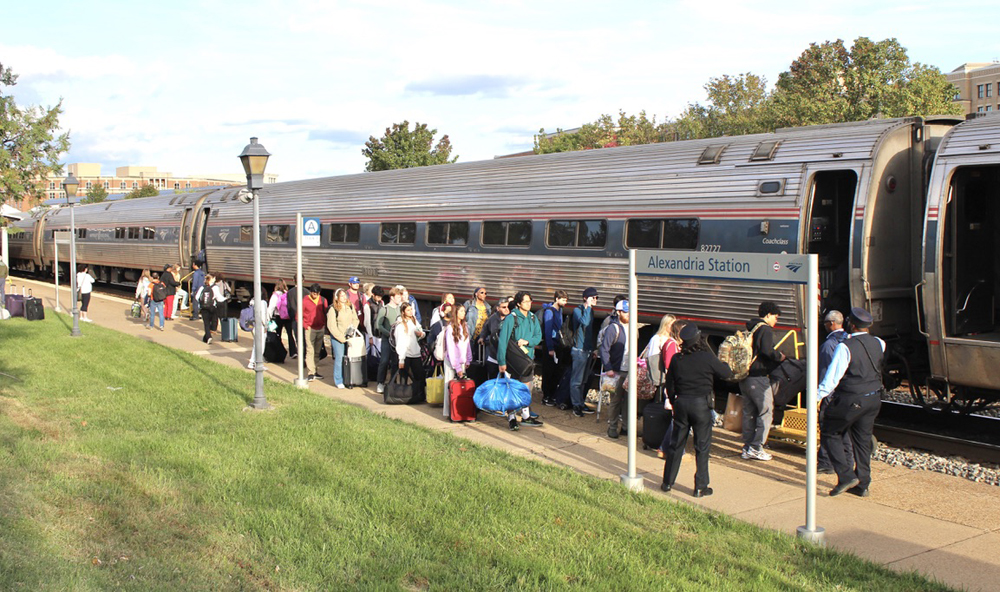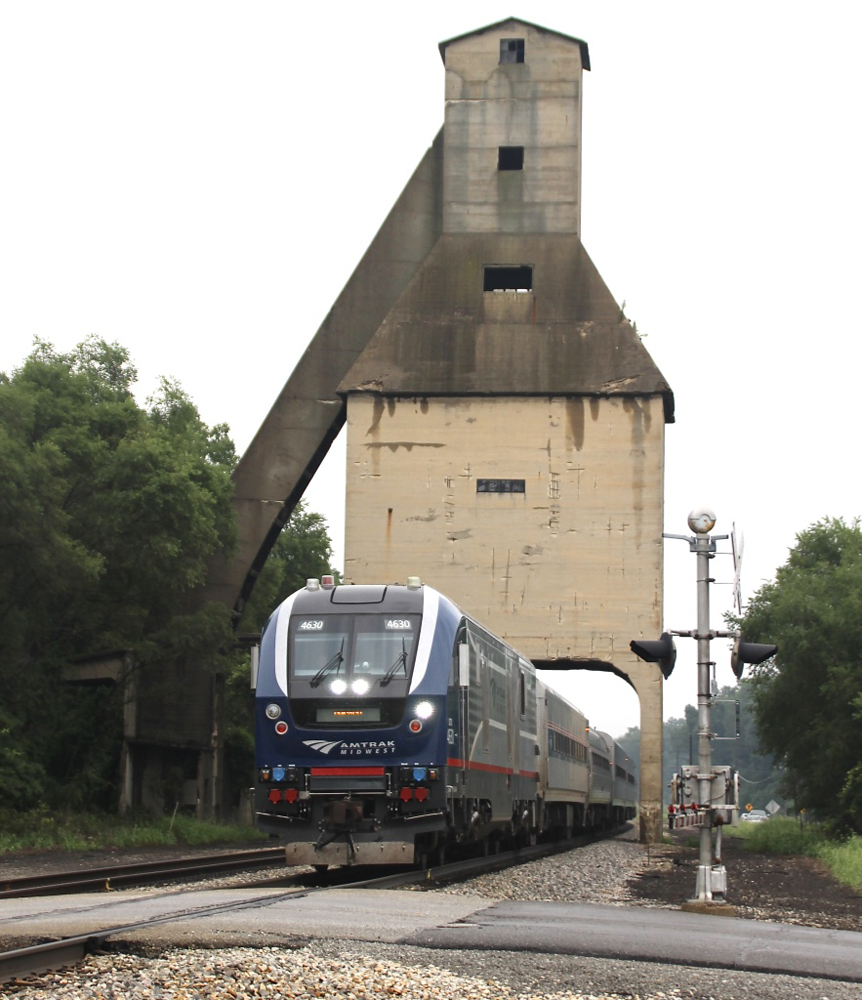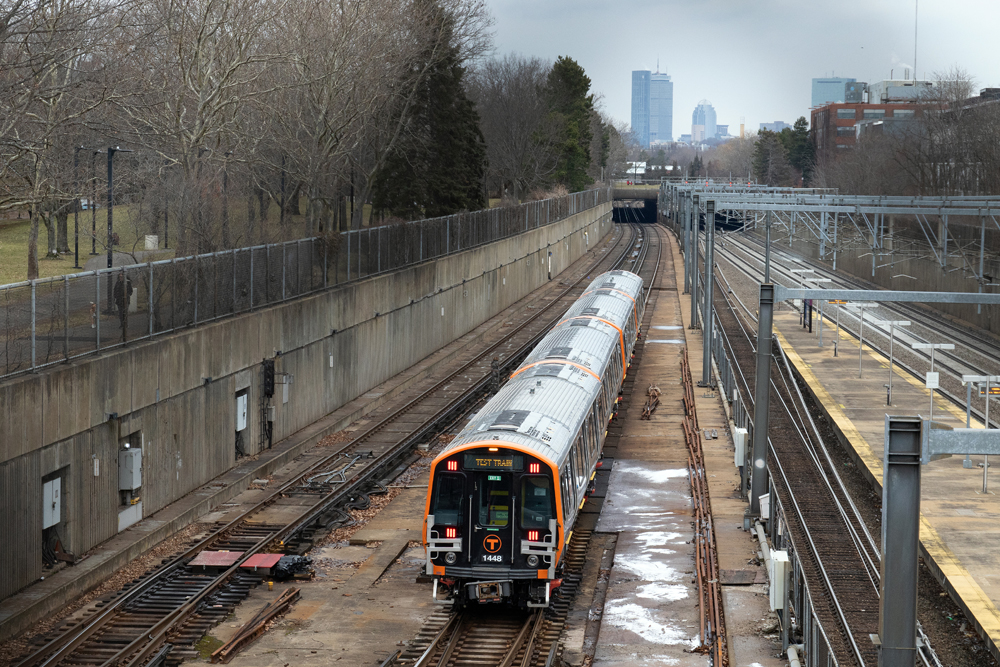EADS, Colo. — The company interested in buying Union Pacific’s dormant Tennessee Pass line through the Colorado Rockies would do so to provide a more direct route for grain shipments from eastern Colorado and Kansas, according to the company’s lawyer.
Colorado Pacific Railroad, which bought the former Missouri Pacific Towner Line in eastern Colorado, notified Union Pacific of its interest in buying the former Denver & Rio Grande Western line earlier this month, and UP said it would entertain offers. [See “UP considering sale of Tennessee Pass route,” Trains News Wire, Nov. 19, 2019.]
In a statement to the Kiowa County (Colo.) Independent, attorney William Osborn said Colorado Pacific owner Stefan Soloviev “is taking this step because a substantial portion of the time, eastern Colorado and western Kansas grain producers will get better prices if they ship using the shortest railroad route to the West Coast, instead of the Texas Gulf Coast, for the export market … This is part of a continuing effort to open up eastern Colorado farm ground to west coast and pacific export markets for wheat and milo.”
Soloviev is owner of Crossroads Agriculture and was described in a Bloomberg article earlier this year as “heir to a $4.7 billion fortune” and America’s 31st largest land owner. The Bloomburg article described his desire to extend his railroad in Colorado “to the West Coast and beyond.”













The former MILW mainline between Appleton, MN and Terry, MT is swimming with traffic now. BNSF is even running Z-trains on it, and the entire former CMStP&P Aberdeen Division main is now TWC with ABS, versus the mix of CTC and pseudo-CTC (i.e. “poor-man’s” CTC = controlled signals only, with hand-thrown switches) it had during Milwaukee days. All this now goes the former NP route west of Terry, ironically on MRL (“Milwaukee Road Lives”) to Sandpoint, ID. I imagine this route will get even busier as time goes on, perhaps even getting some more controlled sidings beyond Summit and Glenham, SD now (Aberdeen West is also a CTC “island”).
BNSF will be especially-glad to have the former MILW in north-central SD when time comes to replace the Missouri River bridge on the old NP between Bismarck and Mandan, ND as the ex-GN Hi-line would be hard-pressed to absorb all the traffic off the NP, even for the few weeks the reroute would be needed.
Just because the route they are looking maybe shorter in mileage does NOT mean that it will be faster. One thing that seems to be forgotten about Tennessee Pass here is the very rough 3% grade. If these people are considering running unit grain trains over the line, they’d better have very deep pockets for power requirements to accomplish their goal of “fast west coast grain movement” (should it ever come to fruition.)
I’ll believe it when I see it – but it sure would be nice! Maybe they’d even allow the Royal Gorge Route Train operators to run a couple of passenger specials over the entire line. I’d sure sign up for that!
…The Bloomburg article described his desire to extend his railroad in Colorado “to the West Coast and beyond.”
Um, Mr. Soloviev…trains don’t swim.
I think they have built very expensive condos on the yard, or former yard, in Minturn. Much of the rest of the line is in horrific condition. Can’t see this happening but sure wish it could.
Oh boy more Milwaukee Road PE theories. You guys all know there was only one through freight train on the PE between Seattle and Chicago for decades after it was built. Not sure when train #2 was added but holy cow that part alone should give you pause on it’s profitability. As for the PE suddenly becomming profitable after the BN Merger. If you search online you can find the feasibility study that was done in the 1970-1980’s of resucing the PE by the Milwaukee Road. They were going to rebuild it with 90lb welded rail, refresh the ties and bridges as well. Look at their projected price tag for that vs the additional revenue they thought it would bring in. They did that feasibility study prior to making the final decision on abandonment. So tell me how they missed the profitability of the PE the very last time with their feasibility study on a proposed rebuild? Remember all those tunnels would need to be fixed for double stack containers. Cha-Ching!
John: Yes, I am aware of the “any positive cash flow of the MILW PE was being funneled back into propping up the losing granger routes in the midwest” theory. This is debatable considering how many of these routes in the Midwest have endured. As example is CP buying the DM&E/IC&E – not for a shot at the Powder River Basin coal (wow, would that have been a disaster) – but to get the ex-MILW line to Kansas City. Another is the main routes saved by the state of South Dakota. There are others, but no one sought to acquire the Pacific Extension for any of these same reasons.
Kelly: I would challenge you to provide ANY documentation that BNSF would want Tennessee Pass. It and Soldier Summit is not attractive for running today’s heavy trains. As for turning over business at Dotsero for BNSF to handle to Seattle: I suggest checking out a BNSF system map to see why that’s not going to happen.
Everyone is forgetting that BNSF has wanted to buy the Tennessee Pass line from UP for years, and they also have trackage rights on the Moffat route to SLC. BNSF could team up with Colorado Pacific (probably under the table so UP wouldn’t balk at selling) providing money, power and MOW equipment to get the track up to snuff. Colo Pacific would turn the train over to BNSF at Dotsero for forwarding to the Seattle area for shipment overseas. A win-win for what Colo Pacific is wanting to accomplish and for BNSF to finally have another way across Colorado with a more friendly connection. Of course, this is just conjecture from a dumb trucker that has no experience in any of these high dollar poker games!
@Michael Moss Yes 3+% Eastbound 1.4+% Westbound had my directions backward
@Mark Meyer. I think what Anna was saying was that any positive cash flow of the MILW PE was being funneled back into propping up the losing granger routes in the midwest. The question in play was, did it ever exist?
As for the MILW PE and PSR, many had made assertions that due to no online business, the route had no revenue base to work from.
My assertion was that when the container boom came into play the MILW had some of the right parts for PSR. My thought was simply with no encumbrances for local service, they could run long consists without the use of extensive sidings. But I agree that by the 1970’s, most containers would have derailed somewhere between Cle Elum and Spokane and therefore was in no position to accept it.
Yes, I have read the MILW myths site and there is a lot of religion around the fallen flag.
Correction to previous: “It would take 11 units to get the train over Tennessee Pass.” Five or six, rather. The concept of the power modifications remains the same.
John Rice said, “In an era of PSR, the MILW PE would be doing very well since it eschews online services to prefer long distance A to B traffic.”
This myth is akin to what Curt Warfel stated earlier: “To borrow on an old joke; how do you become a millionaire? Start with $4.7 billion and buy a steep mountain railroad…”: When a man selling pencils on the street corner for five cents was asked how he could make money since he bought the pencils for a dime, he responded, “I’m going to make it up in volume!!!”
The Milwaukee Road was the high-cost route (http://trainweb.org/milwaukeemyths/). Such business would naturally go to the more-efficient routes.
Anna:
With regard to electrification, you fell into the same trap that all the “proponents” of such an operation (for heavy freight trains in the U.S.) do: You didn’t mention or weren’t aware of the largest costs: Locomotive modifications, locomotive dwell between power modifications, and train delay waiting for power to be available at the locomotive modification point. The only instance where these aren’t applicable is when the locomotive power does not need to be modified en route. And I sincerely doubt that any discussion in this threat assumed electrifying not only Tennessee Pass but the entire route beyond to California (or multiple routes to California and/or a route to the Pacific Northwest where the vast majority of grain export facilities are located on the U.S. West Coast).
Example: A standard 110-car grain train weighs about 16,000 tons. And we’ll assume that Colorado Pacific electrified its railroad from Eads to Dotsero for however many billions of dollars that would take. We don’t know what type of electric locomotive this fictitious railroad would use, but let’s say one of them would pull about as much as a standard C44 of today, just to make it easy. It would take 11 units to get the train over Tennessee Pass. When the 11 locomotives get to Dotsero to hand off the train to UP, they are worthless because the railroad is not electrified beyond there. Assuming that traffic would not be heavy off a lightly-used branch line as is the case now, the inbound 11 units would have to be repositioned back east for the next train. Since this railroad is meant to handle grain, the power could go on grain empties coming sometime, but all 11 units would not be necessary since the empty train is so much lighter. Meanwhile, UP is going to need 9 (diesel-electric) locomotives to get this train over Soldier Summit. This power would need to be repositioned to Dotsero. Whatever time this power sits at Dotsero waiting for the Colorado Pacific to deliver the train is locomotive dwell and this is an actual cost. If the train waits at Dotsero for the new power from the UP, this is train delay and this has a definite cost, too. There is a huge cost to reposition power. This whole situation is very complex to explain, but suffice it to say that the result is that there are many expensive assets that would need to dedicated and positioned to handle this one train.
By contrast, five or six such diesel-electric locomotives could move the train from Pueblo to California via an all-UP or all-BNSF route (depending on the route used). And given that the UP would need to handle the train west of Dotsero anyway, they could easily undercut the Colorado Pacific. Even if the Colorado Pacific magically beamed the train Dotsero, the UP would rather take such a train across Wyoming than over Soldier Summit.
And, that the Milwaukee Road (Pacific Extension) “was actually paying for itself” is laughable when one considers that if it did, it would have had money to extend sidings, install CTC, put at least ABS in the unsignaled “gap” between Plummer and Marengo, and invest in safety appliances such as commonplace hot box detectors (it did none of these things).
The Tennessee Pass grade is 3% EASTBOUND, and about half that westbound.
Funny how a discussion of the TennPass sparks talk about the MILW.
In an era of PSR, the MILW PE would be doing very well since it eschews online services to prefer long distance A to B traffic.
Unfortunately they died before Asian containers went nuts.
I am pretty sure they would end up interchanging with UP at the Dotsero. Whether this would be more economical that interchanging with UP or BNSF at Pueblo is questionable. Nevertheless, I wish them well.
Looking at this, Colorado Pacific wants to run westbound. Westbound is hard grade up and easier grades in the downgrade westbound..
Is there room on the ex SP or WP from Salt Lake to Northern California?
To borrow on an old joke; how do you become a millionaire? Start with $4.7 billion and buy a steep mountain railroad…
ANNA – Re: Regenerative braking. Can be done without wires. Just have one big battery pack, as does a hybrid automobile. The so-called enviros believe anything/ everything can be connected to a battery. So can a diesel locomotive. Just call it a Prius Train.
Virginian Railway
So, yesterday afternoon I was walking on part of the former right of way of the Virginia Railroad, in the town of Victoria, Virginia, and thinking to myself about Henry Huttleston Rogers (and Henry Flagler) and the long-gone era of tycoons building their own railroads out of their own funds. And the cojones of it. Could never happen again. How many steam locomotives and railroads could any of the present day billionaires buy and operate, and yet they do not.
But, apparently, here we are.
Perhaps these folks think they can’t get better rates shipping via the underused yet operational Moffatt route? They’re going to use the former Western Pacific from SLC??? I’m all for spending loads of someone else’s money on obscure routes, but…
In 2010 I followed the old MILW right of way from Avery, ID to Terry, MT, and concluded that the many grades and lack of local traffic were indeed the issue. So much track, so many grades, so little on line traffic.
Mister Kayganich:
Actually, my first reaction was that if the Tennessee Pass were to be electrified its operating cost would decrease. The thing about diesels is that with regenerative braking all you get is waste heat, and the energy you are dissipating thereby originated in diesel fuel – it is not recoverable. With electrification you can dump this energy back into the grid and it is not wasted. Think of it as an abstract form of a funicular.
True, the installation cost is higher. You have to install the catenary, arrange an electrical supply, and purchase electric units of some form (which can include converter cars feeding diesel unit traction motors), but it is well known that in general operating costs for electrical equipment are lower than operating costs for chemically powered equipment.
At this point someone would have to sit down with all the estimated costs and generate an accurate scenario on which way to go.
The Milwaukee Road Pacific Extension was abandoned for reasons other than its electrification. These reasons are fairly complex but include the fact that there was a lack of traffic being generated along the route. If I recall correctly, when the final forensic analysis was done on the breakup of the Milwaukee Road the Pacific Extension was actually paying for itself, but there were “financial irregularities” being perpetrated which indicated otherwise.
Looking at the larger picture. Can this be read to believe the days of the Rail Barons are returning? Stay tuned to this channel.
The above comments are genetic in nature and do not form the basis for an attorney/client relationship. They do not constitute legal advice. I am not your attorney. At Krazy Ernie’s ATM our exchange rates are INSANE!!!!!!!
I don’t get it. Their current railroad ends at Pueblo, where I’m guessing they connect with BNSF and UP. And isn’t that exactly what they would reach at the other end of the pass?
Whomever this proposed buyer is had best first talk to Uncle Pete about a long-term contract because the TennPass route doesn’t reach the west coast or for that matter reach much of anywhere.
If Uncle Pete with all his connecting routes can’t make a go of TennPass, how could anyone else?
This will never happen. Shortest does not always equal the least expensive or most efficient – especially for heavier trains, which unit grain trains tend to be. The vastly lower-cost alternatives would be to route the product from Pueblo south to Amarillo via BNSF’s Boise City subdivision, then west to California, or a UP routing via Denver, Laramie, and Ogden.